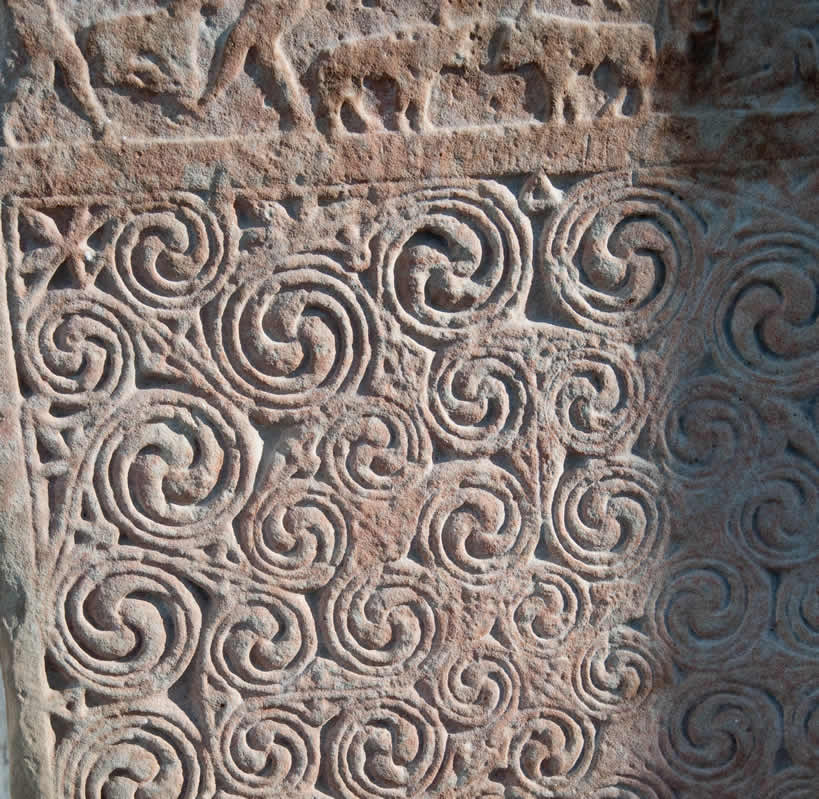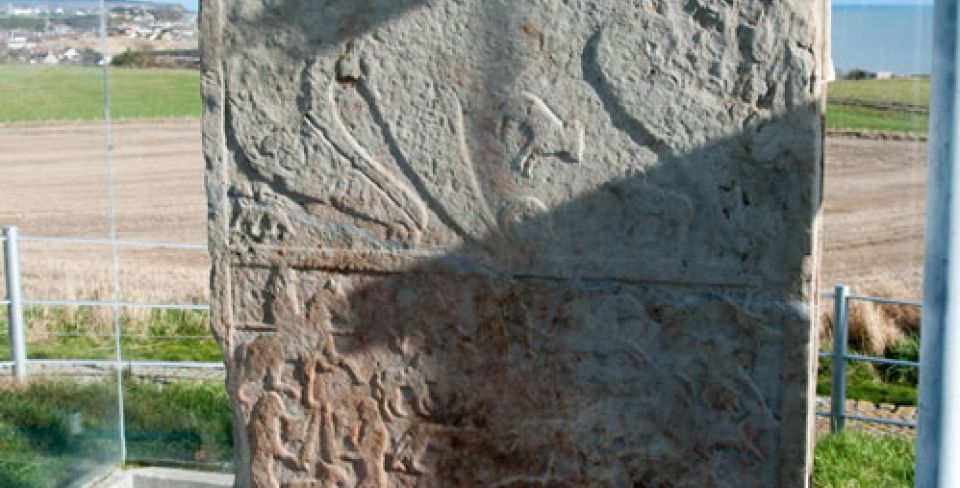8.3 Shandwick
The cross-slab stone at Shandwick is covered with Christian symbols. This is an expression of Pictish Christianity rather than being a stone which combines pagan and religious designs.
There were probably a number of monastic settlements along this coast under control of the large monastery at nearby Portmahomack.
The stone is called Clach a’Charaidh in Gaelic meaning ‘stone of the grave plots’.
It lies slightly inland and has been preserved in a glass shelter. It is said to have been a landmark for sailors traveling along this coast.
The cross consists of circular bosses and is surrounded by interlocking spirals. Across the surface of the stone, intertwined snakes coil around each other.
These snakes had a religious significance – they are associated with evil and the temptation of Adam and Eve. In medieval times, snakes also signified rebirth and regeneration as they burrow underground and re-emerge having shed their old skin.

There are five panels of decoration on the back of the stone. The carvings include beasts, hunting scenes, men on horseback, fighting swordsmen and a hunter carrying a cross-bow.
Tarbat Ness
- 8.1 Tarbat Discovery Centre, Portmahomack
Between 1994 and 2007 archaeologists excavated an area around the church of St Colman at Portmahomack on the tip of Tarbat Ness. They discovered an extensive monastic settlement dating from the late 6th century. The Tarbat Discovery Centre tells the story of this Christian settlement and its re-discovery by archaeologists....
- 8.2 Hilton of Cadboll
Tarbat Ness is home to a number of standing stones which reflect the artistic skill and Christian faith of the Pictish people who carved them. The stones may have marked the boundary of the lands controlled by the monastery at Portmahomack. The cross-slab at Hilton of Cadboll is a replica...
- 8.3 Shandwick
The cross-slab stone at Shandwick is covered with Christian symbols. This is an expression of Pictish Christianity rather than being a stone which combines pagan and religious designs. There were probably a number of monastic settlements along this coast under control of the large monastery at nearby Portmahomack. The stone...
- 8.4 Nigg Stone
The Nigg Stone is one the finest carved Pictish stones. It was carved around 800AD - or perhaps earlier - and is covered in Christian symbols From the details of this carved stone, it is clear that there were close links between monks living in Nigg and Portmahomack, and the...
- 8.5 Craig Phadraig
Craig Phadraig is a wooded hill on the edge of Inverness. Follow the path up the hill to discover the possible remains of King Brude’s fort. Colmcille’s biographer Adomnán describes the saint visiting King Brude, the Pictish king, at his fort somewhere near the River Ness - possibly here at...
- 8.6 Other Pictish Stone Sites North of Inverness
Other Pictish stone sites Explore the history of the Picts along the east coast from Inverness northwards. The Highland Pictish Trail Trail highlighting 17 sites with Pictish stones, ranging from Inverness to Dunrobin near Golspie. A Catalogue of Pictish Stones at Inverness Museum and Art Gallery The catalogue lists all...










Bòrd na Gàidhlig
Great Glen House
Leachkin Road
Inverness
Scotland, IV3 8NW
(+44) 01463 225454
colmcille@gaidhlig.scot
Colmcille
Foras na Gaeilge, 2-6 Queen Street
Belfast
Northern Ireland
BT1 6ED
(+44) 028 9089 0970
colmcille@forasnagaeilge.ie
Colmcille
Foras na Gaeilge, An Chrannóg
Na Doirí Beaga
Gaoth Dobhair
Donegal, Ireland. F92 EYT3
(+353) 074 9560113
colmcille@forasnagaeilge.ie


